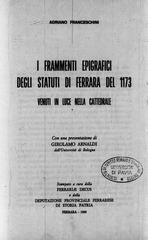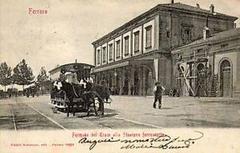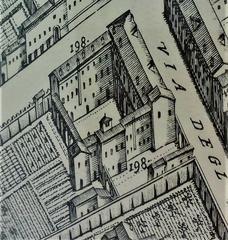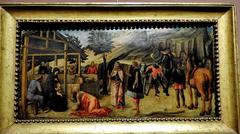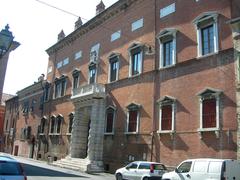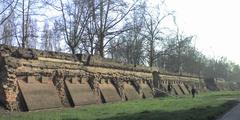Ferrara Synagogue: Visiting Hours, Tickets, and Historical Significance in Ferrara, Italy
Date: 03/07/2025
Introduction
The Ferrara Synagogue, nestled in the heart of Ferrara’s historic center, stands as a testament to Jewish resilience, culture, and heritage spanning over five centuries. As one of Italy’s oldest continuously operating synagogues, it offers visitors a unique window into the rich tapestry of Jewish life, religious diversity, and artistic achievement within a city that once boasted a flourishing Jewish community of more than 2,000 individuals. Alongside the adjoining Jewish Museum, the synagogue provides an immersive experience of history, art, and remembrance, making it an essential destination for cultural travelers, history enthusiasts, and anyone interested in Jewish heritage (MoreTimeToTravel; Jewish Heritage Route; Ferrara Terra e Acqua).
Historical Overview
Origins and Community Flourishing
The Ferrara Synagogue’s origins date to 1485, when Ser Samuel Melli, a prominent Roman Jewish banker, donated a building to serve as a communal center for Ferrara’s Jewish population (Ferrara Terra e Acqua). Under the Este dynasty, Ferrara became a haven for Jews expelled from Spain, Germany, and other regions in the late 15th and early 16th centuries (Italy Magazine). By the mid-16th century, the Jewish community had grown to over 2,000, making Ferrara a major center for Jewish scholarship, Hebrew printing, and commerce (JGuide Europe).
Ghettoization and Resilience
After Ferrara’s annexation to the Papal States in 1598, Jews were confined to a ghetto in 1627, centered on Via Mazzini. Despite restrictive measures, Ferrara’s Jewish community maintained vibrant religious and social life, with the synagogue complex at its heart (Italy Magazine). The ghetto was abolished in 1859, but the area retains much of its historic character.
20th Century and the Shoah
The community faced severe persecution during the Fascist era and World War II, with nearly 200 Jews deported from Ferrara. Two of the synagogue’s prayer halls were destroyed during this period, leaving the Scola Tedesca as the main surviving worship space. Today, the synagogue and museum serve as both places of worship and centers for Holocaust remembrance (JGuide Europe; Ferrara Terra e Acqua).
Architectural and Artistic Significance
Exterior and Urban Context
Reflecting social and legal pressures of the past, the Ferrara Synagogue’s exterior is modest and blends seamlessly into the cityscape, marked only by commemorative plaques and memorial stones (Academia.edu). The entrance on Via Mazzini is unobtrusive, in keeping with Italian synagogue tradition.
Interior Highlights
Scola Tedesca (German Synagogue)
The Scola Tedesca is the only original prayer hall still used for religious ceremonies. Renovated in 1820 in the Regency/Empire style, it features a barrel-vaulted ceiling with elegant plasterwork, a women’s gallery, and exquisite wooden furnishings, including the original bimah and Torah ark (Wikipedia; Ferrara Terra e Acqua).
Scuola Italiana and Scuola Fanese
The former Scuola Italiana, now a venue for community events, houses wooden arks from both the Italian and lost Spanish synagogues, symbolizing Ferrara’s layered Jewish history. The Scuola Fanese, used for Sabbath worship, further reflects the diversity of Jewish traditions in Ferrara.
Artistic Details
- Woodwork: The synagogue’s Torah arks and bimah are masterpieces of Italian woodworking, richly carved and adorned with Jewish motifs.
- Decorative Arts: Ceilings and walls feature Jewish iconography and neoclassical designs, merging Italian artistry with religious symbolism.
- Memorial Tablets: Stone tablets at the entrance honor Holocaust victims, serving as a poignant reminder of the community’s trials (Academia.edu).
Social and Cultural Role
The Ferrara Synagogue has always been more than a place of worship. It was a center for education, charity, and communal governance, housing spaces for study, meetings, and social services (Jewish Heritage Route). The community contributed significantly to Ferrara’s economic and cultural life, especially as a center for Hebrew printing and scholarship. The synagogue and museum now play a central role in cultural preservation and Holocaust remembrance.
Visiting the Ferrara Synagogue and Jewish Museum
Location and Access
- Address: Via Mazzini 95, 44100 Ferrara, Italy (MoreTimeToTravel)
- Centrally located in Ferrara’s historic Jewish Quarter, easily walkable from major city attractions.
Visiting Hours
- General Hours: Tuesday to Sunday, 10:00 AM – 5:00 PM. Closed Mondays and during Jewish holidays.
- Guided Tours: Typically available at set times in the morning; check the official website for current schedules and possible changes due to restoration works.
Tickets and Admission
- Standard Admission: €6 for adults; free for children under 12.
- Discounts: Reduced rates for students, seniors, and groups. The Ferrara Card grants access to multiple attractions.
- Purchase: Tickets can be bought on-site or through authorized online platforms (The Travel Folk).
Accessibility
- The synagogue is partially accessible for visitors with mobility impairments. Due to the historic nature of the building, some areas may be challenging; contact the museum in advance to discuss specific needs.
Guided Tours and Educational Programs
- Tours are offered in Italian and English; booking in advance is recommended, especially during peak seasons. The museum also organizes educational workshops for schools and groups.
Visitor Etiquette
- Modest dress is required.
- Photography may be restricted during services and in some areas; always ask staff before taking photos.
Exploring Ferrara’s Jewish Quarter
Layout and Atmosphere
The Jewish Quarter (Ghetto Ebraico), centered on Via Giuseppe Mazzini, is one of Italy’s best-preserved Jewish neighborhoods (Summer in Italy). Medieval streets, terracotta facades, and tranquil pedestrian lanes create a unique atmosphere.
Key Sights
- Jewish Cemetery: Via delle Vigne, open daily 9:00 AM – 6:00 PM. Over 1,400 tombstones, including the grave of author Giorgio Bassani.
- Via Vignatagliata: Site of the historic communal oven.
- Stolpersteine: Brass plaques commemorating Holocaust victims embedded in the pavement.
- National Museum of Italian Judaism and the Shoah (MEIS): Via Piangipane 81. Open Tuesday to Sunday, 10:00 AM – 7:00 PM. Extensive exhibitions on Italian Jewish history.
Travel Tips
- Getting There: Ferrara is accessible by train from Bologna and Venice. The Jewish Quarter is walkable from the train station and city center.
- Best Time to Visit: Spring and autumn offer pleasant weather and fewer crowds.
- Maps and Resources: Download maps from local tourism portals or pick them up at tourist information centers.
- Local Life: Enjoy artisan shops, cafes, and the tranquil ambiance of the quarter.
Frequently Asked Questions (FAQ)
Q: What are the Ferrara Synagogue visiting hours?
A: Tuesday to Sunday, 10:00 AM – 5:00 PM; closed Mondays and Jewish holidays.
Q: How do I buy tickets?
A: Tickets are available on-site or via authorized online sellers. The Ferrara Card is also valid.
Q: Is the synagogue accessible for people with disabilities?
A: Accessibility is partial; contact the museum for details.
Q: Are guided tours available in English?
A: Yes, but advance booking is recommended.
Q: Can I take photos inside the synagogue?
A: Photography may be restricted during services or in certain areas; check with staff.
Conclusion and Final Tips
The Ferrara Synagogue is a living monument to centuries of Jewish heritage, artistry, and resilience. Its layered history—from Renaissance prosperity through ghettoization and the tragedies of the Shoah—offers profound insight into Jewish life in Italy. Exploring the synagogue, Jewish Museum, cemetery, and surrounding quarter provides a rich, immersive experience for every visitor. For the best visit, check current hours and ticket options, consider booking a guided tour, and take time to explore the wider Jewish Quarter and MEIS.
Enhance your visit with the Audiala mobile app for audio guides and up-to-date information, and follow local tourism channels for the latest news and events.
Visuals and Resources
High-quality images of the synagogue’s interior and exterior are available on official tourism websites. Virtual tours and downloadable maps can help you plan your visit efficiently.
Sources
- Jewish Virtual Library - Ferrara
- Emilia Romagna Turismo - Jewish Community of Ferrara
- MoreTimeToTravel - A Visit to the Jewish Museum of Ferrara
- Ferrara Terra e Acqua - Synagogues
- Summer in Italy - Jewish Ghetto of Ferrara
